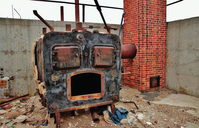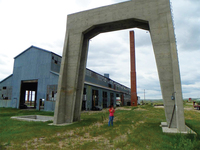Late June, several years ago while visiting the Black Hills, my husband tells me we should take a drive to an old army base that he had mapped out. “Sure”, I say with excitement as that is a place on our exploring bucket list that we had not photographed yet. For hours we drive to the south western border of South Dakota along the Nebraska and Wyoming borders to “No Man’s Land”, I would call it. Very few communities did we pass through along the way as the sun blazed across miles and miles of prairie land. We arrive at a town named Provo, not really a town at all as there were only a few standing homes and the massive junk yard of old cars out numbered any residents still living here.
Ryan says, “let’s take this gravel road; according to my map this should be the way in.”
We drove a rough dirt road, more like a path it seemed at times, that winded through the thick prairie grass. Finally coming to an open gate at the southern most edge of the army base. The sheer monstrosity of the area is overwhelming. This is an urban exploration and ghost town aficionado’s dream. It’s hard to recount the feelings of eeriness, awe and amazement looking at all the abandoned structures. It really made you think about an era gone by, seeing all the building
remnants, I tried to imagine the place full of life when it was an operational army base. So much had been built, and so much had been abandoned. A lone new satellite dish attached to a house there really was creepy.
It didn’t seem like anyone was home. Relieved as I was picturing a man and a shot gun shouting get off my property. The first sign of life was a jack rabbit that nearly scared the life out of me. Before getting out of the truck, Ryan says, “watch out for rattlesnakes out here”. What?!! So instead of being eager to march across this land to all that is before us of collapsed buildings and bizarre structures still standing I now had to be aware of predators lingering in the tall grass waiting to strike at me. And lucky for the both of us we did not encounter the feared rattlesnake, nor any other creature wanting to do us any harm.
We spent hours exploring the overgrown airstrip with some decrepit hangars near some factory-looking buildings and a sprawling complex of ammunition’s depots, army barracks,
hospital remnants, amongst many other buildings that lie abandoned.
The ghost town of Fort Igloo is so close, yet so far away. You feel you’re on the edge of civilization (you kind of are), as you enter a land of many buildings, but few people. The roads leading around the base can be a bit confusing as some roads are so overgrown you can hardly tell they are there. And others are completely closed off with padlocked gates and barb wire fencing as we found out while trying to get a closeup picture of the ammunition bunkers. Across the rugged prairie more than 800-bunkers once used to store weapons and ammunition for the military still dot the landscape, other structures have been reduced to ruins by the passage of five decades, but the ammunition bunkers remain as sturdy as ever. These cement and earthen covered mounds resemble igloos, hence the name Fort Igloo that the residents of Black Hills Ordinance Depot lovingly nicknamed their base and the name has held over time.
We still have not entered the front of the base and with the dark clouds rolling in with a possible storm approaching we make our way to the first paved road we find with a street sign reading Igloo. We see a beat up old pick up truck drive through what was the front gates at one time, but well-placed tractor tires leaning against the cement wall are spray painted with the omen “NO TRESPASSING”. Even the brick guards building that is still standing is shouting at us with the same message painted on it’s front. I look over at Ryan and ask, “well what are you waiting for?” He says, “this is a bad idea.” Yes, it does say, NO TRESPASSING, but I don’t listen and decide I am going to stop and ask at the residence inside for permission. Before I could knock on the door of the old
army barrack now turned into a home, this older man, larger than life opened the door. He did not appear to be someone who wanted to have a conversation and looked at us with a stone-cold stare. I introduced myself as Angella Pechous (this was before Ryan and I had married),
and asked his name, he replied with, “Jack.” I asked him about getting some pictures of the base and he said no immediately. But we stood and talked for over a half hour.
We asked Jack about the history of Fort Igloo, who owns buildings at the abandoned base and lives there with just a handful of neighbors.
He says that the land is slowly being returned to its original purpose before the arms depot was built in 1942.
Fort Igloo came to an end in the summer of 1967, when the government shut down the arms depot, the base was ultimately abandoned. Fort Igloo has become a veritable ghost town. But even though most of the people have gone many of the buildings remain. The land is currently owned by several private parties. In all, it is more than 21,000 square acres and in the 1950’s was listed as the 15th largest city in the state. Known as Fort Igloo, because of the shape of the bunkers, the Black Hills Ordinance Depot was home to more than just weapons. Thousands of people lived and worked at the base.
Frankly, calling Fort Igloo a storage facility doesn’t even do it justice. In addition to the concrete storage bunkers, the 33 square mile complex once included all the amenities of a well-planned town. In addition to living quarters for over a thousand people, Fort Igloo also boasted an Army hospital, a school district, day-care center, movie theater, bowling alley, skating rink, post office, church, shopping facilities and other mainstays of small-town America including a swimming pool and a recreation center. These amenities were actually a necessity due to the remote and isolated location. Indeed, the isolation was also a necessity dictated by the mission of the Depot and the nature of items warehoused there.
Black Hills Ordinance Depot was conceived, built and opened during World War Two with the mission of receipt, storage, issue and maintenance of ammunition. The depot also housed several hundred Italian prisoners of war beginning in 1943. The facility performed its mission through three wars and was eventually closed. All types of ammunition were stored here from small arms ammunition to artillery rounds, bombs and chemical weapons.
The sprawling nature of the base along with its remote location in southwestern South Dakota provided a relatively safe buffer in case of a deadly mishap.
After Jack shared the history of Fort Igloo we exchanged where we were from. Ryan told him he grew up in the Upper Peninsula of Michigan and I told him I’ve lived most of my life in a little town called Tyndall in the far southeastern part of South Dakota. We also shared what we did for a living. It turned out Jack grew up in Michigan, and his daughter in law was from Tabor. I asked for her name which he shared. When I had a photography studio in Yankton with my mom years ago, we had done her senior pictures, family pictures, and even her wedding. After telling this to Jack and him remembering these two crazy woman photographers at his son’s wedding, well Jack looked over at me and said, “Ms. Pechous go take your pictures, but because of liability stay out of the buildings.” What was the chances of that, small world right!
We do as Jack has said, in fact we do a basic drive through of this portion of the base shooting pictures out of the truck and never getting out. Mainly because it has gotten awfully late in the day and we have several hours of a drive back but also out of respect for Jack and his family. Jack had also told us as he pointed across the road, that the church once stood not all that long ago but because of trespassers and vandals it was burnt down, this is the case of several buildings that are no more.
Curiosity seekers are advised not to trespass on this private land which is now used largely for cattle grazing. Much of the base is fenced with two rings of security and the main entrance which is flanked by the symbol of the US Army Ordnance Corps as well as a symbol of the present ranch environment. I will be forever grateful for the opportunity given to us by Jack, but also I take away the sense of privacy and security that Jack and his neighbors have strived for. They have the ominous greeting of no trespassing, as a way to safe guard their homes and their livelihood of raising cattle, but also to protect what is left of the history of Fort Igloo.






